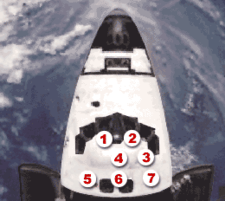STS-42
 Spacelab in Discovery's payload bay | |||||
| Mission type | Microgravity research | ||||
|---|---|---|---|---|---|
| Operator | NASA | ||||
| COSPAR ID | 1992-002A | ||||
| SATCAT № | 21846 | ||||
| Mission duration | 8 days, 1 hour, 14 minutes, 44 seconds | ||||
| Distance travelled | 4,701,140 kilometers (2,921,150 mi) | ||||
| Orbits completed | 129 | ||||
| Spacecraft properties | |||||
| Spacecraft | Space Shuttle Discovery | ||||
| Launch mass | 110,400 kilograms (243,400 lb)[1] | ||||
| Landing mass | 98,890 kilograms (218,020 lb)[1] | ||||
| Payload mass | 13,066 kilograms (28,806 lb) | ||||
| Crew | |||||
| Crew size | 7 | ||||
| Members |
Ronald J. Grabe Stephen S. Oswald Norman E. Thagard William F. Readdy David C. Hilmers Roberta L. Bondar Ulf Merbold | ||||
| Start of mission | |||||
| Launch date | 22 January 1992, 14:52:33 UTC | ||||
| Launch site | Kennedy LC-39A | ||||
| End of mission | |||||
| Landing date | 30 January 1992, 16:07:17 UTC | ||||
| Landing site | Edwards Runway 22 | ||||
| Orbital parameters | |||||
| Reference system | Geocentric | ||||
| Regime | Low Earth | ||||
| Perigee | 291 kilometres (181 mi) | ||||
| Apogee | 307 kilometres (191 mi) | ||||
| Inclination | 57.0 degrees | ||||
| Period | 90.5 min | ||||
  Left to right: Oswald, Bondar, Thagard, Grabe, Hilmers, Merbold, Readdy
| |||||
STS-42 was a Space Shuttle Discovery mission with the Spacelab module. Liftoff was originally scheduled for 8:45 EST (13:45 UTC) 22 January 1992, but the launch was delayed due to weather constraints. Discovery successfully lifted off an hour later at 9:52 EST (14:52 UTC).[1] The main goal of the mission was to study the effects of microgravity on a variety of organisms. The shuttle landed at 8:07 PST (16:07 UTC) on 30 January 1992 on Runway 22, Edwards Air Force Base, California.[1] STS-42 was the first of two flights in 1992 of Discovery, the second of which occurred during STS-53, which launched on 2 December 1992. The mission was also the last mission of the Space Shuttle Discovery to have a seven-member crew until STS-82, which was launched on 11 February 1997.
Crew
| Position | Astronaut | |
|---|---|---|
| Commander | Third spaceflight | |
| Pilot | First spaceflight | |
| Mission Specialist 1 | Fourth spaceflight | |
| Mission Specialist 2 | First spaceflight | |
| Mission Specialist 3 | Fourth spaceflight | |
| Payload Specialist 1 | Only spaceflight | |
| Payload Specialist 2 | Second spaceflight | |
Crew seating arrangements
| Seat[2] | Launch | Landing |  Seats 1–4 are on the Flight Deck. Seats 5–7 are on the Middeck. |
|---|---|---|---|
| S1 | Grabe | Grabe | |
| S2 | Oswald | Oswald | |
| S3 | Thagard | Hilmers | |
| S4 | Readdy | Readdy | |
| S5 | Hilmers | Thagard | |
| S6 | Bondar | Bondar | |
| S7 | Merbold | Merbold | |
Crew notes
The crew of STS-42 included West Germany's first astronaut, Ulf Merbold, who was making his second spaceflight, and Canada's first female astronaut, Roberta Bondar. In order to allow around-the-clock monitoring of experiments, the astronauts were divided into a red team and a blue team. Manley L. Carter, was originally assigned to fly as Mission Specialist 3 for this mission, but died 7 months prior the launch in a plane crash. David Hilmers was then chosen to replace him.
Mission highlights

STS-42 was launched on 22 January 1992, 9:52:33 am EST. The launch was delayed by one hour due to weather constraints. The launch weight was 243,396 pounds (110.403 Mg).
Discovery carried into orbit the International Microgravity Laboratory-1 (IML-1), a pressurized manned Spacelab module, to explore in depth the complex effects of weightlessness on living organisms and materials processing. The international crew, divided into Red and Blue teams, conducted experiments on the human nervous system's adaptation to low gravity and the effects of microgravity on other life forms such as shrimp eggs, lentil seedlings, fruit fly eggs and bacteria. Low gravity materials processing experiments included crystal growth from a variety of substances such as enzymes, mercury iodine and a virus. Other payloads included 10 Get Away Special (GAS) canisters, a number of middeck payloads and two Shuttle Student Involvement Program (SSIP) experiments. Middeck payloads included Gelation of SOLS: Applied Microgravity Research (GOSAMR), Investigations into Polymer Membrane Processing (IPMP) and the Radiation Monitoring Experiment (RME-III).
The mission landed on 30 January 1992, 8:07:17 am PST, Runway 22, Edwards Air Force Base, CA., after being extended by a day for continued scientific experimentation. The rollout distance was 9,811 feet. The orbiter returned to Kennedy Space Center on 16 February 1992. The landing weight was 218,016 pounds (98.890 Mg).
Mission insignia
The four stars in the lower blue field and two stars in the upper blue field of the insignia symbolize the flight's numerical designation in the Space Transportation System's mission sequence. The single gold star above the horizon on the right is in honor of astronaut Manley "Sonny" Carter, who was killed in the crash of Atlantic Southeast Airlines Flight 2311 in Brunswick, Georgia while on a commercial airplane traveling for NASA. Carter was originally assigned as a mission specialist on STS-42 at the time of his death.
See also
- List of human spaceflights
- List of Space Shuttle missions
- Nikon NASA F4
- Outline of space science
- Space Shuttle
References
![]() This article incorporates public domain material from websites or documents of the National Aeronautics and Space Administration.
This article incorporates public domain material from websites or documents of the National Aeronautics and Space Administration.
External links
| Wikimedia Commons has media related to STS-42. |